Lochaline Trip Report - 16-18 August 2024
Report from Eddie Adie
It feels like heading to Lochaline is a bit of an annual pilgrimage for Deep Blue Scuba. I’ve been visiting the Sound of Mull for 15 years, and DBS has for longer than that – just ask Tom C. It is a firm favourite with many of the dive team and hopefully we have managed to introduce a few folk to the joys of the Sound of Mull over the years.
This year on Thursday 15 August, twelve of us headed over to Lochaline via the short Corran Ferry crossing, with a few of the group stopping en route for a couple of shore dives. We stayed in accommodation at the Highland Basecamp, just a short walk from where we would board our dive boat the next day. Each of the rooms have bunk beds, underfloor heating and an ensuite toilet/shower room. There is also a well equipped kitchen and social space, and a drying room to hang drysuits or other bits of damp kit.
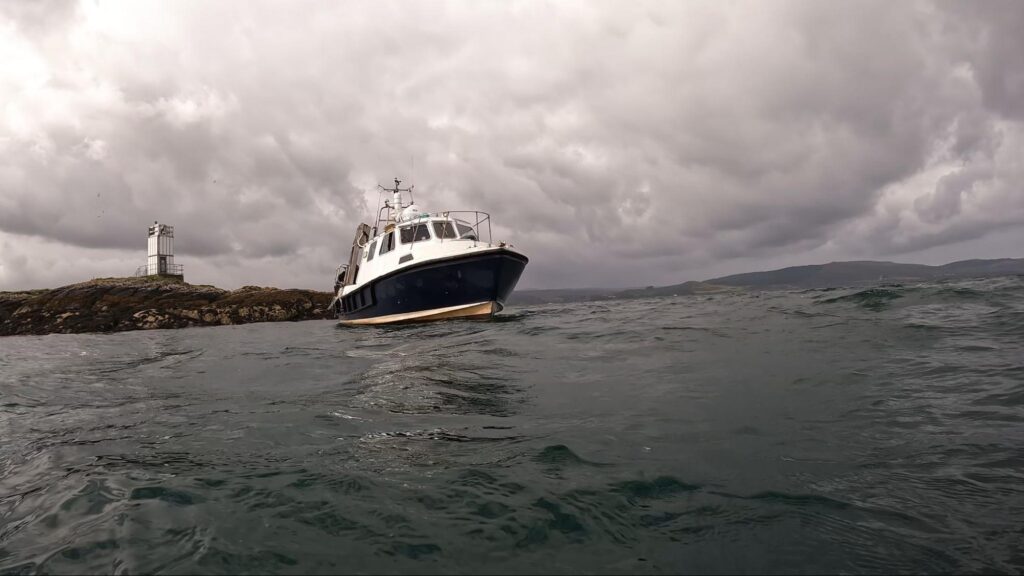
After a wee chat with Malcolm on Thursday evening, it was agreed that we would start our three day trip with a dive on the Thesis wreck. We would be diving on the Brendan, one of Lochaline Boat Charters two dive boats (the other being Peregrine) with our skipper Bodie.
The first job – after breakfast – on day 1 was to get all of our dive gear onto the Brendan. It’s a smashing dive boat with a dive lift, compressor for fills, toilet, galley and dry space. When everyone was on board, and after completing the safety briefing, we were on our way (with a wee stop to watch sea eagles) to the Thesis.
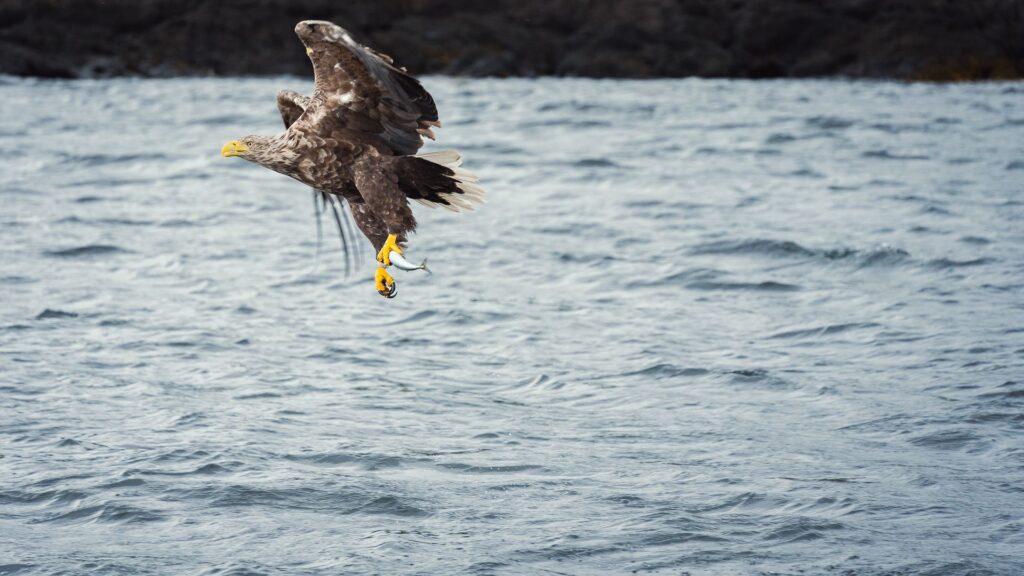
Dive 1 – Thesis
Thesis was launched in Belfast on 28 January 1887 measuring approximately 51 x 8 x 3.5 metres. Details about the loss of Thesis are vague, other than to say it happened while travelling from Middlesbrough to Belfast with a cargo of pig iron in October 1889. About midnight on Tuesday 15 October 1889 the Thesis grounded on Inniemore Point, Morven and sank. The crew were able to escape safely.
Today, the Thesis wreck lies on a sloping shingle seabed. The bow points to shore and lies around 20 metres, while the stern lies about 30 metres. The wreck itself is really just the hull of the ship as all superstructure and decking have gone. In recent years storms caused much of the wreck to collapse so the bow section is no longer as impressive as it was, however this remains a lovely dive with plenty of life to be seen.
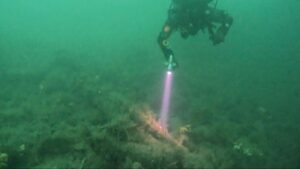 After investigating the wreck, my buddy and I went in search of the anchor.
After investigating the wreck, my buddy and I went in search of the anchor.
It can be found on the port side of the wreck and has a handy line laid to it so it’s fairly easy to locate. Once that was found we headed off to the nearby reef to see what we could find. A 52 minute dive with a maximum depth of 31 metres.
Dive 2 – Shuna
Cargo steamship Shuna was launched in the Netherlands on 29 April 1909 measuring approximately 73.5 x 11 x 5 metres. At around 10pm on 8 May 1913, en route from Glasgow to Gothenburg with a cargo of coal on board, the ship hit rocks and began to take in water. Whilst trying to reach the safety of Tobermory, it became clear this would be impossible as the inrush of water was too great for the pumps to handle. The Shuna was therefore deliberately run ashore on the Morvern coast with the aim of carrying out repairs and refloating later. By the early morning of 9 May 1913, it was clear that nothing could be done to save the Shuna. The crew abandoned ship and reached the shore safely in the lifeboats and Shuna slipped beneath the surface.
The Shuna wreck is an excellent dive sitting upright in around 30 metres of water, parallel to the shore, on a gently sloping seabed with the deck 16 – 20 metres from the surface. The four holds, engine room and raised forecastle still give a clear picture of the Shuna’s former layout. The holds are still full of coal but it is possible to descend into some other areas below deck level.
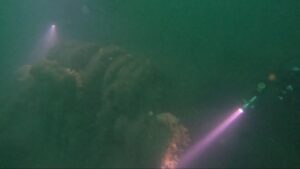 I really enjoy diving the Shuna, even though it is silty and it is important to keep an eye on your buoyancy, as well as your NDL, as the wreck is basically level, so most of the dive will be between 22 and 25 metres.
I really enjoy diving the Shuna, even though it is silty and it is important to keep an eye on your buoyancy, as well as your NDL, as the wreck is basically level, so most of the dive will be between 22 and 25 metres.
A 52 minute dive with a maximum depth of 31 metres.
With that, day 1 was done and we headed back to Lochaline. Tea for most of us was from the Lochaline Snack bar who serve up excellent Fish & Chips (and other goodies) every Friday. Top tip if you are on a future Lochaline trip is to phone in your order in advance!
The plan for day 2 was to dive a wreck and a scenic site, with a stop in Tobermory for our surface interval.
Dive 3 – Hispania
Built and launched in Belgium in 1912, the steamship Hispania measured approximately 72 x 11 x 5 metres. Its final voyage began on Friday 17 December 1954 from Liverpool, loaded with a cargo of steel, asbestos and rubber, bound for Varberg in Sweden. The weather was poor as Hispania steamed north through the Irish Sea and the North Channel so the route was altered to give some protection from the weather by sailing between the islands of the Scottish west coast. Around 9pm on 18 December 1954, nearing Tobermory, the ship ran onto a reef close to the Mull shore. Although the crew managed to ease Hispania off the reef, the end was inevitable as the ship was listing heavily to port and taking in water rapidly. After running out an anchor to avoid being swept away in the strong tides of the Sound the twenty one crewmen launched two lifeboats but could not convince their captain to come with them. After about an hour, Hispania plunged beneath the surface, probably due to the bulkhead giving way, with Captain Ivan Dahn standing on the bridge with (so the story goes) his hand raised to his forehead in a defiant salute. The crew rowed across the Sound and landed safely on the Morven shore.
The Hispania’s cargo was salvaged and the site was wire swept in the 1950’s however otherwise the wreck is still intact sitting upright with a slight list to starboard, in 30 metres of water. The bow points due west towards Mull. Depths on the deck range from 15 – 20 metres with of course the holds and engine room much deeper.
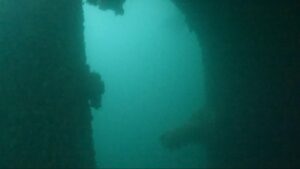 Hispania is a spectacular wreck with almost every square inch covered in life. For that reason this is considered one of the best scenic wreck dives in Scotland. The ship, although one of the most dived wrecks in Scotland, is still virtually intact with companionways and handrails still in place. A highlight for me is the large rudder with the space where the propeller once was, a magnificent site and very photogenic. This is very definitely a slack water dive, so sometimes there is a bit of hanging around for the tide to be just right… not for us though, Bodie judged things beautifully and after kitting up slowly, we were ready to jump! A 50 minute dive with a maximum depth of 27 metres.
Hispania is a spectacular wreck with almost every square inch covered in life. For that reason this is considered one of the best scenic wreck dives in Scotland. The ship, although one of the most dived wrecks in Scotland, is still virtually intact with companionways and handrails still in place. A highlight for me is the large rudder with the space where the propeller once was, a magnificent site and very photogenic. This is very definitely a slack water dive, so sometimes there is a bit of hanging around for the tide to be just right… not for us though, Bodie judged things beautifully and after kitting up slowly, we were ready to jump! A 50 minute dive with a maximum depth of 27 metres.
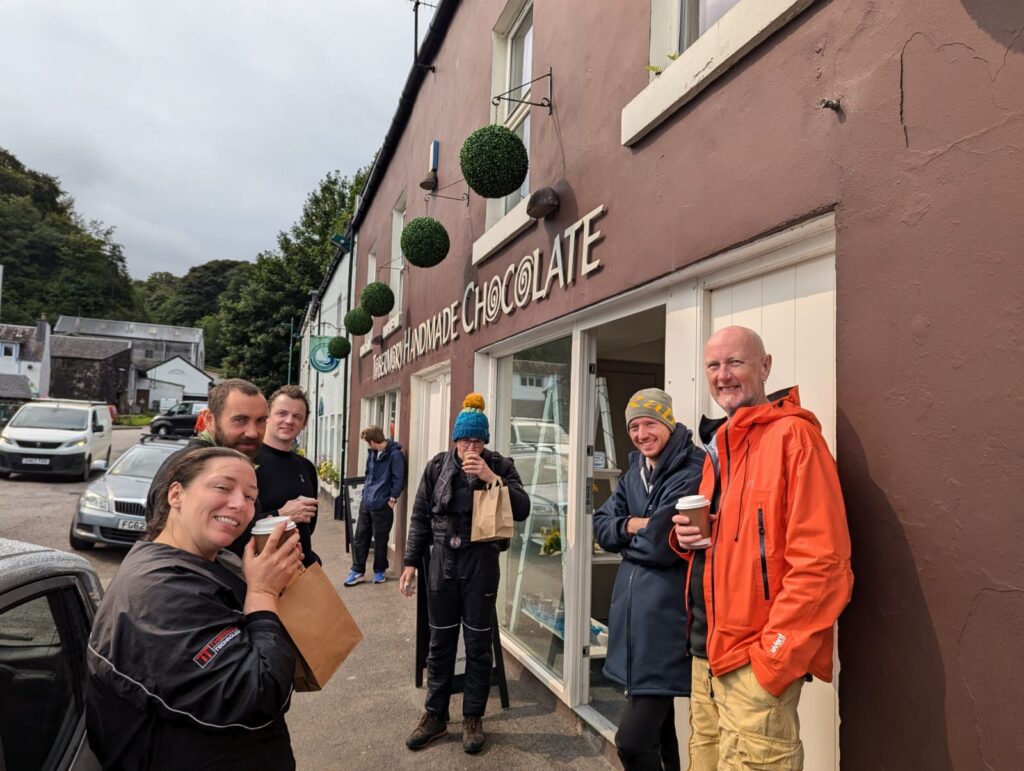
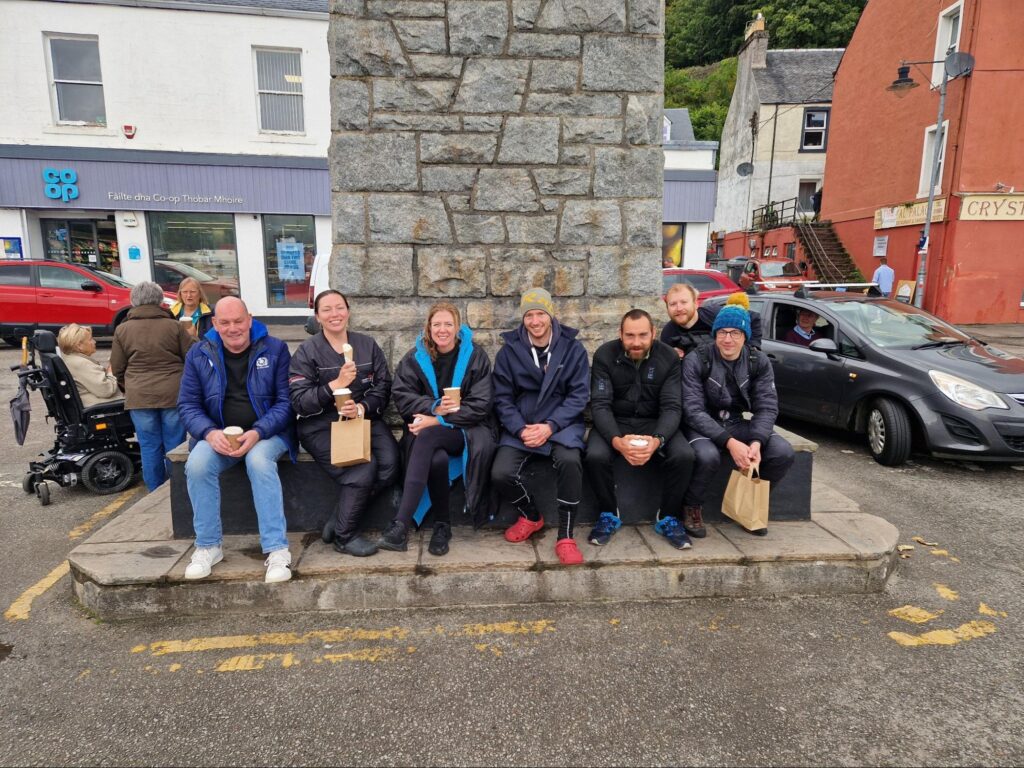 I always enjoy visiting Tobermory, it’s a lovely wee town with brightly coloured buildings (You might recognise it as Balamory?). You can get excellent coffee, hot chocolate, cakes, ice cream and other treats – some of us may even have taken the opportunity to replenish our whisky stocks with a bottle or two from the distillery!
I always enjoy visiting Tobermory, it’s a lovely wee town with brightly coloured buildings (You might recognise it as Balamory?). You can get excellent coffee, hot chocolate, cakes, ice cream and other treats – some of us may even have taken the opportunity to replenish our whisky stocks with a bottle or two from the distillery!
Dive 4 – Calve Island
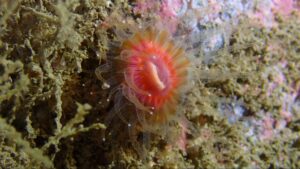 This is a scenic wall dive close to Tobermory, so as soon as we returned to Brendan we kitted up. Navigation on the site is easy – Pick your depth (the wall goes down to around 50 metres), go with the current if there is one, or keep the wall on your left or right. There is so much to see from the usual kelp, dead man’s fingers, devonshire cup corals, various types of anemone, starfish, crustaceans, cat sharks, moray eels, and nudibranchs. A 65 minute dive with a maximum depth of 22 metres.
This is a scenic wall dive close to Tobermory, so as soon as we returned to Brendan we kitted up. Navigation on the site is easy – Pick your depth (the wall goes down to around 50 metres), go with the current if there is one, or keep the wall on your left or right. There is so much to see from the usual kelp, dead man’s fingers, devonshire cup corals, various types of anemone, starfish, crustaceans, cat sharks, moray eels, and nudibranchs. A 65 minute dive with a maximum depth of 22 metres.
After agreeing a plan for day 3 with Bodie, that was a wrap for day 2, so off back to Lochaline we went. Pizza at the social club for some of us, self catering at Highland basecamp, or the fabulous White House restaurant for others then reconvening for a wee blether and a few laughs – no kittens were harmed… apart from those that exploded!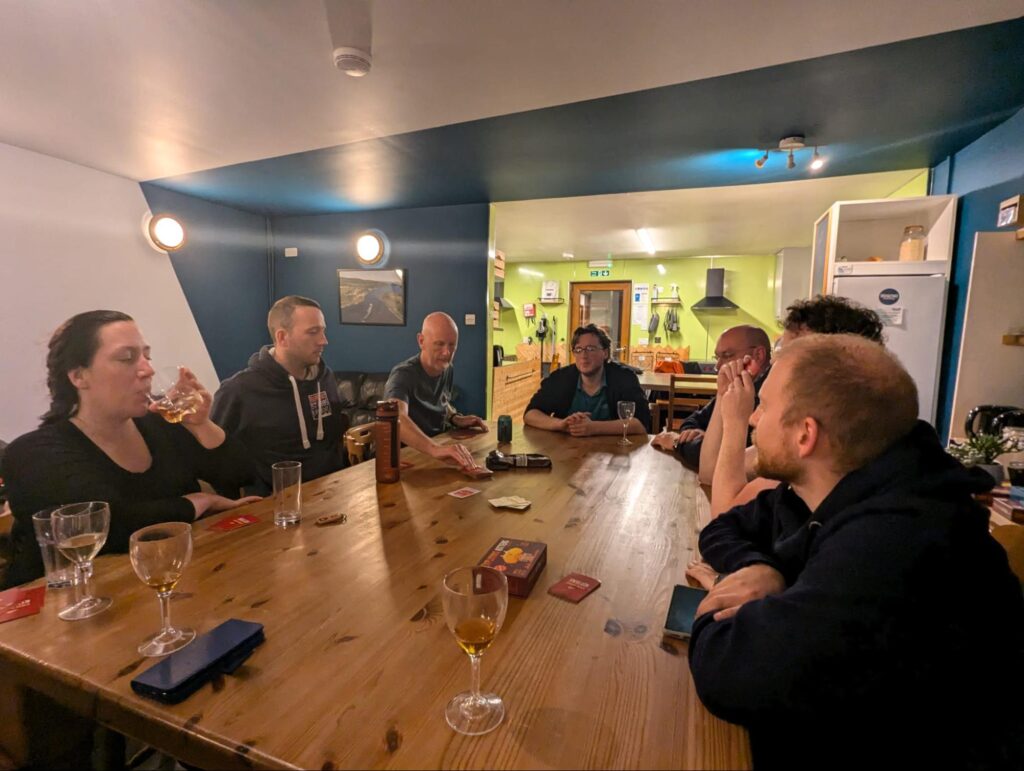
Dive 5 – Rondo
Built in the USA in the last frantic months of World War 1 and named “War Wonder 1”, “Lithopolis”, “Laurie”, and finally “Rondo” in 1934 the Rondo was some 80 x 13 x 6.5 metres in size. In January 1935 the Rondo left Glasgow for Dunstan in Northumberland planning to sail north round the top of Scotland and down the east coast to collect cargo for onward transportation to Oslo. On 25 January 1935, during atrocious weather, Rondo was forced to anchor near Tobermory for shelter.
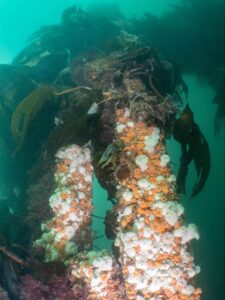 Unfortunately, the anchor chain parted and Rondo began drifting east down the Sound driven by the strong winds and tide and was swept onto Dearg Sgeir almost demolishing the small lighthouse as she crashed ashore and stuck fast on the rock. The Rondo was eventually abandoned and work began to break the ship up. This activity was well under way when finally the ship slipped off the rock and sank, bow first, in the deep water close to the island.
Unfortunately, the anchor chain parted and Rondo began drifting east down the Sound driven by the strong winds and tide and was swept onto Dearg Sgeir almost demolishing the small lighthouse as she crashed ashore and stuck fast on the rock. The Rondo was eventually abandoned and work began to break the ship up. This activity was well under way when finally the ship slipped off the rock and sank, bow first, in the deep water close to the island.
I have to confess that this is absolutely my favourite dive site in the Sound of Mull. It is one of the area’s most dramatic wrecks as the Rondo sits almost vertical, on her bow which crashed into the seabed about 50 metres below the surface, while the rudder post is often visible from the boat only a few metres below the surface.
The hull is all that remains lying against the steep rocky cliff but the metal of the ship is completely covered in a colourful mass of orange, white and green plumose anemones and dead men’s fingers plus a multitude of other encrusting sea life.
The wreck is always patrolled by shoals of curious wrasse and huge saithe and pollock making it more like a dive on a tropical reef than on a Scottish wreck.
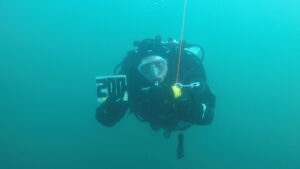 A special mention here to Aimee who you see here completing her 200th dive!
A special mention here to Aimee who you see here completing her 200th dive!
An excellent site for a significant dive well done Aimee.
My buddy and I headed down the port side of the wreck to our maximum depth and then zig zagged our way back up (with a wee stop at about 30 metres to say hi to a massive moray eel) to 18 metres where we headed off the starboard side to investigate a lovely rocky reef before returning to the wreck and ascending to complete our 5 metre safety stop at the rudder section. The reason I love this dive so much is that, apart from it being so dramatic, it is effectively 3 dives in 1; a deep dive, on a wreck, with a reef to explore and with ample opportunities to get photographs. A 57 minute dive with a maximum depth of 45 metres.
Dive 6 – JP Wall
Our final dive of the weekend was on a site called JP Wall, named after the wreck of the John Preston which sank on 2 December 1882 and lies near the wall. To be perfectly honest, there is very little (if any) of the wreck now visible on the site, however its cargo of slates can still be seen strewn at around 18 metres. The wall is a beautiful scenic site with a diversity life on show. It does get deep as it reaches about 65 metres, so divers can pick their depth (subject to having suitable certification). A 66 minute dive with a maximum depth of 20 metres.
And with that our diving was over. Brendan headed back into Lochaline for the final time on our trip, we unloaded our kit, and said our farewells before heading home.
In my opinion, one of the best things about the overnight trips that DBS organises is the opportunity to spend time with divers from the club, share experiences and have a few laughs along the way. I really enjoyed myself so much over the 3 days, so to Stuart, Aimee, Jorge, Adrian, Tom C, Alex, Angela, Tom J, Ellis, Steven and Becky thanks for joining the trip and for making it such great fun!
Eddie Adie
Divemaster #354390, Membership Coordinator, and Happy Diver!
